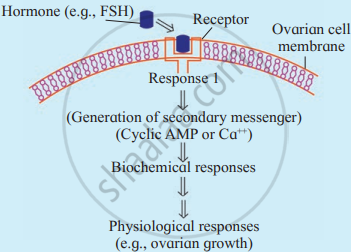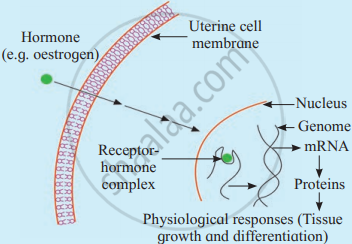Advertisements
Advertisements
Question
Long answer question
Explain the action of steroid hormones and proteinous hormones.
Solution
Hormones are released in very minute quantities. They produce their effect on the target cells by binding to hormone receptors. The hormone receptors are present on the cell membrane (i.e. membrane receptors) or maybe intracellular receptors.
i. Mode of hormone action through membrane receptors:
a. Hormones like catecholamines, peptide, and polypeptide hormones are not lipid-soluble and they cannot enter their target cells through the plasma membrane. These non-steroid water-soluble hormones interact with surface receptors and initiate metabolic activity.
b. Molecules of amino acid derivatives, peptide hormones bind to specific receptor molecules located on the plasma membrane.
c. The hormone-receptor complex causes the release of an enzyme adenylate cyclase from the receptor site. This enzyme forms cyclic AMP from ATP of the cell.
d. cAMP activates enzymatic actions. The hormone acts as the first messenger and the cAMP acts as the second messenger.
e. Some other secondary messengers are Ca++, cGMP, and IP3 (Inositol triphosphate), etc.
ii. Mode of action through intracellular receptors:
a. Steroid and thyroid hormones are lipid-soluble and can easily pass through the plasma membrane of the target cell into the cytoplasm.
b. In the cytoplasm, they bind to specific intracellular receptors proteins forming a hormone-receptor complex that enters the nucleus.
c. The hormone-receptor complex binds to a specific regulatory site of DNA, in the nucleus.
d. The activated genes transcribe mRNA which directs protein synthesis and enzymes in the cytoplasm.
e. The action of lipid-soluble hormones is slow but long-lasting,

Mechanism of hormone action through membrane receptor

Mechanism of hormone action through intracellular receptor
